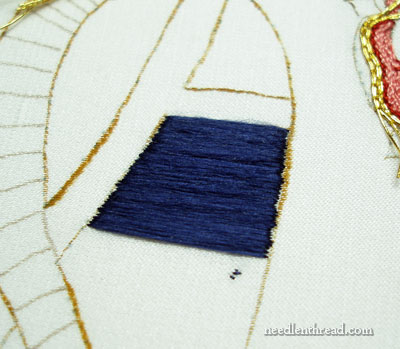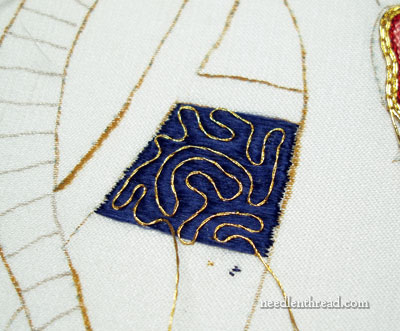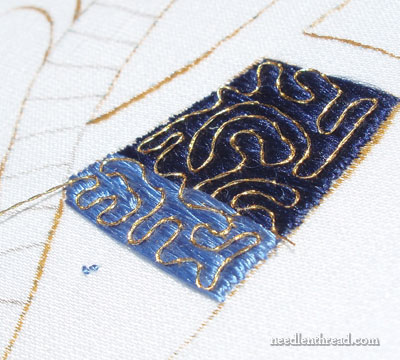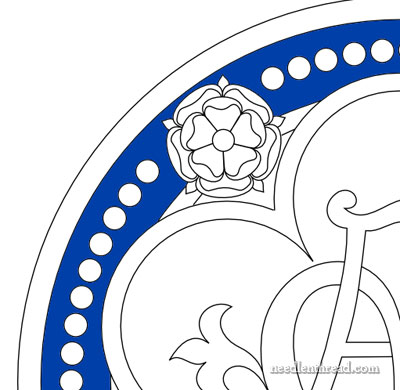In a very old book on church embroidery (Church Embroidery and Church Vestments by Lucy Mackrille), I was quite taken by a technique that the author called the “Italian Stitch.” Why she called it that, I couldn’t tell you. I would guess that it was a stitch common on Italian-made vestments back in the day. But that’s just a guess. And I could be wrong.
I played around with this Italian Stitch once upon a time, and I did end up liking it a lot. In fact, I used it on the background sky in my Agnus Dei project.
I was thinking about using the same technique in the project I’m working on now, so I played around with it – with some variation.

I started with a dark blue flat silk. Flat silk is made from filament silk (straight off the cocoon, as opposed to spun silk, which is made from “left overs” from the cocoon). Flat silk is filament silk that is not twisted, or that has very little twist to it, so little that you can’t really detect the twist. It’s usually stitched in with a laying tool (in Japanese embroidery, a tekobari). I’ve got a handy-dandy video on how to use a laying tool, if you’ve not used one before. The laying tool helps keep the silk nice and flat.
In the photo above, my stitching leaves a bit to be desired. The edge isn’t exactly nice, is it?
When laying silk threads like this, instead of using a regular satin stitch (where you take the thread across the back of the fabric to begin on the same side of the design area with each stitch), you use a laid stitch, where you bring your thread right up next to where you ended your last stitch, to start the next stitch. This technique, since the stitches are much longer than they would be if you were using regular satin stitch, has a few advantages over satin stitch: 1. it saves thread; 2. it helps keep your stitches from becoming slack; and 3. it reduces the chance of long stitches on the back snagging on everything under the sun.
The thread I’m using here isn’t the best flat silk in the world. In fact, it’s probably the worst I’ve ever used. It was incredibly fuzzy (flat silk isn’t characteristically fuzzy!), it tended to pill, and the filaments that made up one strand were irregular in size (some extremely thin, some fat) and tended to break individually. For those of you who have used flat silk, you probably are thinking what I was thinking: this is a nightmare! On the bright side, the American company that produced this particular flat silk (not mentioning any names here) discontinued their line. Smart move, since they didn’t seem to be doing it quite right.
Still, the thread served ok for this test.

After laying down a bit of the flat silk, I couched over a gold thread in a random pattern, to hold the laid stitches down. I’m using Elizabethan twist here. This is a real metal thread made up of two strands lightly twisted together. It is very fine and tiny, and very pretty! To couch the Elizabethan twist, I used 100 wt Tire silk, since it’s the finest gold-colored silk sewing thread that I have on hand. The Tire silk hardly shows on the Elizabethan twist, which is advantageous when doing this kind of couching.

After couching down the dark blue thread, I decided to try a lighter blue, just to see what it would look like. I like this color, even though the couched Elizabethan twist does not show up as well on it. But you know, it’s ok that it doesn’t show up as well, because the purpose of this Italian stitch is not so much to see the pattern of the gold that is couched, but rather to hold the laid threads down and to give the gleam of gold over the silk, without actually “noticing” it in the overall look of the piece.
Chances are, I won’t be using this technique in this project, after all. I was considering it, as a background, but I don’t really want a dark or colored background for the center of the design. The outer edge of the design is made up of about an inch-deep circle, where I would like some color of some sort. This is the outer border area that I’m talking about:

That’s not quite the color of blue, but that’s where I’d like some darker color. How I’ll achieve that color, though, is a topic for another day!
Any questions, comments, suggestions? Feel free to have your say below!







G’day Mary,
Meandering lines like these have always appealed to me. When I was a kid I’d dooldle them on any spare bit of paper (and not spare!) and say I was drawing countries. I believed it too. In Infants I proudly told told my teacher that’s what I was doing in my numbers exercise book. We both learnt something that day! So, now my long ago burst bubble is floating again and I shall do ‘couching countries’ to my hearts content. I think it could possibly fix a puzzling spot in some freeform embroidery that I’m just ‘designing’ as I go.
Cheers, Kath
Hey, Mary, I think the rococo looks nice. I think I know which flat silk you mean. I used it for hair once. Compared to Japanese it is a mess.
I’ve never laid threads, even in very long stitches. Hmm. Always do what we call weft foundation which is long, laid satin stitches.
As for the background, you could always do a lattice over the laid ground of the same color. Also, twisted flat silk that you twist yourself would make a more stable laid ground for the design, but twisted stands out more. Just a thought.
Wow, Mary!
I decided not to add gold embroidery to my needlework but gradually you are converting me to it. Especially today with the meandering lines over blue is stunning. I know it as “Cornelli work”.
Thank you for your continuing study – leading my needle into new adventures. A big thank you & I look forward to future stories.
Cheers, Susan
Good Morning I think the Italian flat stitch is very interesting. What, in your opinion, is a good flat silk. I think that Needlepoint Silk starts out fuzzy, and just get worse.
I have a question on the gold couching thread. You’ve mentioned Tire silk as an excellent one to use for couching and this is the first time I’ve heard of that. What is it, who makes it, where do I get it?
I know that this isn’t exactly about this particular project Mary, but you mentioned your edges on the initial dark blue flat laid silk … well, that’s the problem I have with ALL my satin stitch … & I don’t know how to make it right. Any tips please?
I’m really enjoying seeing how you are working this project.
Cheers, Wendy
Hi, All –
Thanks for your comments! This particular project is going to be a fun adventure, so I’m enjoying sharing it with you. I hope it … uh … turns out the way I picture it! We’ll see!!!!
To answer some questions:
Wendy – I always split stitch over the outline of the area I’m satin stitching, and then I take the satin stitches just over the split stitch line. I think this is a very important step for a crisp edge on satin stitching.
Barbara – I used to buy it from a company called “All Things Japanese” but they’ve recently turned the selling of silk threads over to Superior Threads, and it looks as if they don’t have the 100 wt Tire silk anymore, though Superior does carry 100 wt Kimono silk, which should be the same thing, though I haven’t tried it yet. There are other silks I use for couching threads – I use Soie 100/3 (Au Ver a Soie) for heavier passing threads, for example. But I what I like about the Tire silk is that it is so fine that it really does disappear against the gold. It’s difficult to see, even when waxed. And it’s a strong thread.
Cindy – for the kind of surface work I do, the best flat silk I’ve ever used is Soie Ovale by Au Ver a Soie. Nary a flaw in the stuff! Each bundle of individual “suga” (or filaments) that make up the full strand is plump and full, but at the same time, when it stitches up, it lies very nicely. It’s Good Stuff (disadvantage: limited color range). I’ve also used Japanese flat silk from the Japanese Embroidery Center (in Atlanta – they have an online shop) and it’s very good, too – it’s not quite as thick as the Soie Ovale, and it seems to be a bit wispier. Then there’s Pipers Silk (same stuff as Helen Stevens’s “TESS” silk), which is also a nice flat silk, but each strand (made up of the individual filaments) is even finer than the JEC silk. Pipers (or TESS) is good for very fine detail work (eyes on small faces, for example, or miniature work on very high count silk gauze – 72, for example). Then, finally, last on the list for me, is Eterna silk, which is a Chinese silk. It has many more imperfections in it compared to the previous three silks, but it is usable, and I’ve used it successfully. The advantage of this last one is that it is a whole lot less expensive than the others, and it comes in a huge color range. But you’ll also run into areas that you have cut out of the thread, and there are times when it is a pain to work with. But it’s usable. If Soie Ovale had a more extensive color range, it’s probably the only one I’d ever use for the type of stitching I do.
Susan – Be Careful of Goldwork! You might get hooked!!! 🙂
Anne – Thanks! I bet you do know which flat silk – they discontinued the line a year or two ago, and I had the option of buying at a very deep discount some of their cones. Yeah, well, the discount wasn’t deep enough – this is the first time I’ve had the opportunity to use the flat silk, and wow. It’s just no wonder they discontinued. Or maybe I got a really bad cone. But it’s cranky stuff, let me tell you!!! Just to clarify, the gold thread I’m couching is “Elizabethan twist” not rococco, which wouldn’t take the tight curves so easily – it’s a much stiffer and a heavier thread. I should’ve put my needle in there for size comparison. The Elizabethan twist is really tiny, fine stuff, and very supple. I think lattice work for the background would look a bit too rigid for this style of embroidery, but I did test a little section of it in white, couched over with white, just to see. It’s too…. “quilted pillowy” looking, or something.
I keep oscillating between doing a whole covered background in the middle section or not. The advantage: I would be able to work on linen (a great boon!); the disadvantage, it would add so much more time to the project; but the advantage (the other advantage): it would be a detail that sets the project apart from others like it.
I guess we’ll all have to wait and see what the final decision is!
MC
This is going to be a lovely piece when it is finished…I can see this in rich reds deep rich blues and antique golds with a bit of ivory…All threads in silks…I love the look of silks very rich looking and that slight sheen it gives off….Good luck with this piece Mary..
Mary, ever thought of using Japan gold, couched down in a double line? I think it would look alot richer in the same design. (Only my humble opinion).
You do fantastic work… keep up the good work!
Lynne
Hi, Lynne – Good suggestion! In fact, I want to do that one of these days, on an ornament I want to make, where the couched gold would be the focal point. But for this, I was seeking out a background solution that would be very delicate and hardly noticeable, as there will be a larger goldwork monogram in this area, and I don’t want to the two things to vie for attention. The background, if I did it, would have to be “barely there.” The other option is, of course, no background at all – just the bare fabric, which is fine, too. I’m going to discuss this with the student and see what she things, and then we’ll see where it goes!
MC
Mary,
I see that you’ve taken your original drawing of the design into a computer-assisted drawing program of some kind. Would you be willing to share your process for this?
Thanks,
Julie
Hi, Julie – I use two programs for making my line drawings in vector format: adobe illustrator and inkscape. Inkscape is “shareware” so it is free online, if you don’t have illustrator, and it’s pretty easy to get the hang of, and works well for making the vector drawings. ~MC
Mary, Thanks for the discussion on working with flat silk. I just finished a class, but not the project, using this fiber and did not like working with it. I will be trying your technique and try to get it finished!
Liz
Hi, Liz – flat silk is not always the easiest stuff to work with, that’s for sure. One thing that’s essential when working with it, I think, is a laying tool. It helps to keep the thread smooth and to avoid tangles as you go. ~MC
Hi Mary,
I was having that problem with my satin stitches not being consistent until you enlighted me last week about doing a split stitch around area to be filled. Now the edges look even. OMG my Phillipa Turnbull Jacabeon sampler (even under my new lighted magnifier) looks very good especially since I haven’t done any crewel embroidery for 30 years.
Your website is like having someone next to me when I have a questions, etc.
I’m want to do goldwork so bad, but I’m holding off until I get more experience.
Question, I have been a quilter for 30+ and have done a ton of applique, I have always used YLI 100 silk because it disappears into the fabric so well. Have you used this silk and if so what color to use? Or do you just test it over the gold to see which color disappers the best.
Do they still make Tire and what color do you use for your goldword?
So much to learn, so little time. LOL
Many thanks, Jeannette
Hey, Mary, I meant the style of roccoco, not the thread.
Re the flat silk, in Japanese, we split and combine flat silk a lot. I have not had any success with splitting into 2 equal halves of a strand to twist, etc. That’s what is good about Japanese flat silk. You can divide, twist and recombine.
Ah. Got it! Thanks, Anne. I’ve not yet played with twisting my own Japanese silks – one of these days, I may give that a try!
Hi Mary!
I’ve always loved flat silk. And I love vermicelli couching (the meandering line work…). This “Italian stitch” you speak of is now calling me. I’m going to have to try it out!
I may have to go search out that book on church embroidery, too. At first I thought it was the one on my shelf, but then I realized that it’s not… Hmmmm.
Ah yes, vermicelli couching – thanks for the reminder. I love that name – better than Italian stitch, which pretty much says nothing! It’s a fun technique, Romilly – very “free form” and interesting to see as it takes shape.
What Mrs. Mackrille calls “Italian stitch” Mary-Dick Digges used to call “vermicelli couching”. I loved the name because it does look like “little worms”. I’m interested in the book you cited. Is it a book written in conjunction with the embroidery in the Nat’l Cathedral in Washington? I’ve been hoping to find a copy of that book for years but there were so few printed.
Hi, Cecelia – Yes, that’s the book. It’s available now and then through used book sources, and sometimes it’s very expensive, and sometimes, you can buy it for practically nothing! I paid $100 for the first copy of it that I bought years ago – but it was worth it, because at that time, I couldn’t find any of the older books on ecclesiastical embroidery. Then, a few years later, I found the same book at a library used book sale (in better condition than the copy I previously purchased!) for a mere 50 cents. You can find a copy of it online, too – here’s my review of it, and the links to the online book are in the article there: https://needlenthread.wpengine.com/2007/08/church-embroidery-book-online.html Hope that helps! ~MC
I love the YLI silk. I’ve used 50 and 100 for couching and prefer the 50. The gold is perfect, even better, imho than Tyre. You do have to wax it, though. And, don’t use too long strand as it does untwist. But it is beautiful. And great on the sewing machine, too.
mary’encuentro cada proyecto tuyo muy interesante,,cada material aplicado, yo solo puedo practicar con hilo,la seda se que existe porque tu la planteas,pero para una bordadora siempre habra otra opcion’se ve genial el azul con el oro”’
gracias.
Hi AnneG, I have a lot YLI 100. Now I need to see if I have gold. Goldwork keeps calling me. LOL
Jeannette
Hi Mary,
I was looking at the Tire silk the other day and noticed it had changed distributor. I’d love to know your opinion on the Kimono #100.
Tho it’s great to learn through the comments that the YLI silk is good for couching! I’ve used it for silkwork and hated it, for lack of coverage and er…general silkiness. It is very very cheap (at least on Ebay)
Aloha from Hawai’i !! Very well made information. As a child I was taught to tend old books and manuscripts with inlay of gold leaf, tapping back edges and large letters embossed. I am looking for Gold Thread made of Silk and Gold. If you know where I might find some, for a reasonable cost, please let me know? Please send me a message via my email, or have catalog or response sent to following address:
Thank you so much. Shelley
Hi, Shelley – you might try the Japanese Embroidery Center in Atlanta Georgia. They have an online shop.